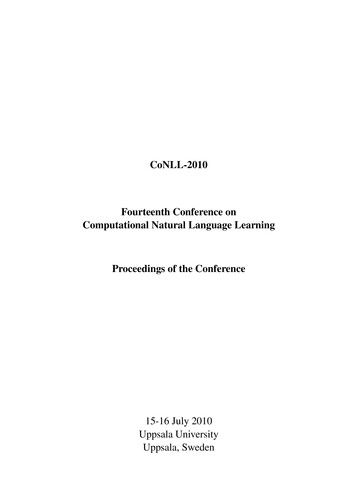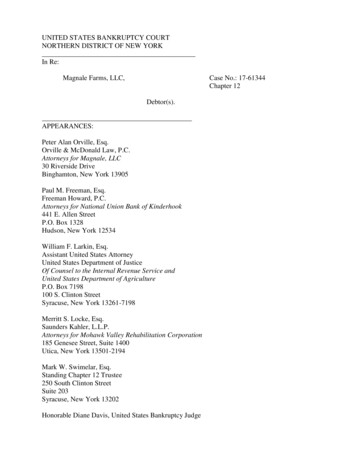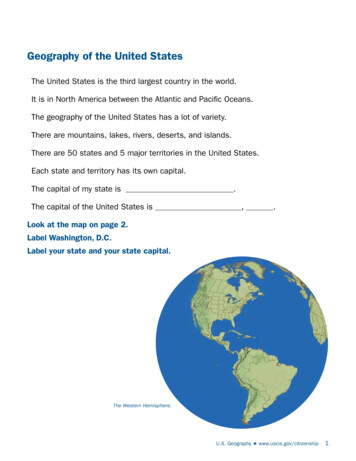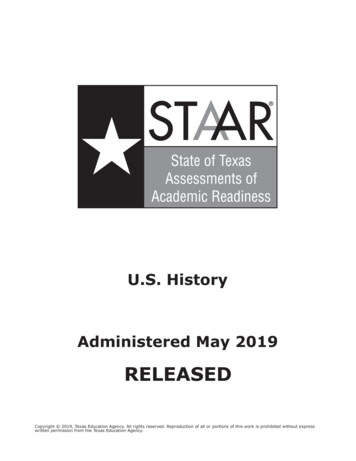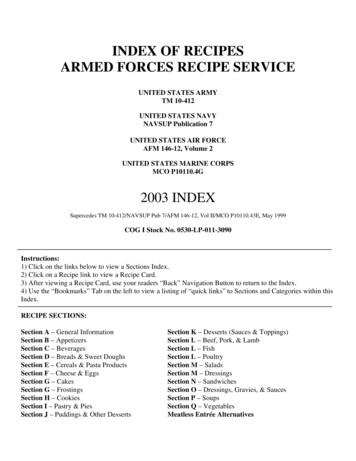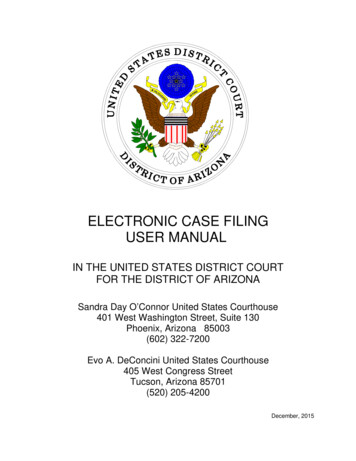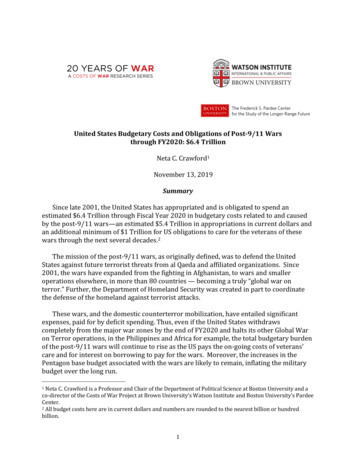
Transcription
United States Budgetary Costs and Obligations of Post-9/11 Warsthrough FY2020: 6.4 TrillionNeta C. Crawford1November 13, 2019SummarySince late 2001, the United States has appropriated and is obligated to spend anestimated 6.4 Trillion through Fiscal Year 2020 in budgetary costs related to and causedby the post-9/11 wars—an estimated 5.4 Trillion in appropriations in current dollars andan additional minimum of 1 Trillion for US obligations to care for the veterans of thesewars through the next several decades.2The mission of the post-9/11 wars, as originally defined, was to defend the UnitedStates against future terrorist threats from al Qaeda and affiliated organizations. Since2001, the wars have expanded from the fighting in Afghanistan, to wars and smalleroperations elsewhere, in more than 80 countries — becoming a truly “global war onterror.” Further, the Department of Homeland Security was created in part to coordinatethe defense of the homeland against terrorist attacks.These wars, and the domestic counterterror mobilization, have entailed significantexpenses, paid for by deficit spending. Thus, even if the United States withdrawscompletely from the major war zones by the end of FY2020 and halts its other Global Waron Terror operations, in the Philippines and Africa for example, the total budgetary burdenof the post-9/11 wars will continue to rise as the US pays the on-going costs of veterans’care and for interest on borrowing to pay for the wars. Moreover, the increases in thePentagon base budget associated with the wars are likely to remain, inflating the militarybudget over the long run.Neta C. Crawford is a Professor and Chair of the Department of Political Science at Boston University and aco-director of the Costs of War Project at Brown University’s Watson Institute and Boston University’s PardeeCenter.2 All budget costs here are in current dollars and numbers are rounded to the nearest billion or hundredbillion.11
OverviewOne of the major purposes of the Costs of War Project has been to clarify the types ofbudgetary costs of the US post-9/11 wars, how that spending is funded, and the long-termimplications of past and current spending. This estimate of the US budgetary costs of thepost-9/11 wars is a comprehensive accounting intended to provide a sense of theconsequences of the wars for the federal budget. Since the 9/11 attacks, the Department ofDefense appropriations related to the Global War on Terror have been treated asemergency appropriations, now called Overseas Contingency Operations (OCO).3 Whenaccounting for total war costs, the Department of Defense and other entities often presentonly Overseas Contingency Operation appropriations.The Costs of War Project takes a broader view of war expenses because budgetary costsof the post-9/11 wars are not confined to military spending. Table 1 summarizes post9/11 war-related costs and the categories of spending. Numbers and occasionallycategories are revised in the Costs of War estimates when better information becomesavailable. For example, this year’s report uses newer interest rate data in calculating theestimated interest on borrowing for OCO spending. Additionally, this report revises theestimate of increases to the Pentagon base budget given new information, described below,on patterns of military spending and the relations between the OCO budget and basemilitary spending. Further, the Department of Defense budget for FY2020 included newcategories, denoting OCO spending intended for the base military budget, reflected in aseparate line in Table 1.See Congressional Budget Office (CBO). (October 2018). Funding for Overseas Contingency Operations and itsImpact on Defense Spending CBO publication 54219. https://www.cbo.gov/system/files/2018-10/54219oco spending.pdf.32
Table 1. Summary of War Related Spending, in Billions of Current Dollars, FY2001–FY2020 Rounded to the nearest billion. BillionsOverseas Contingency Operations (OCO) AppropriationsDepartment of Defense4State Department/USAID5Estimated Interest on Borrowing for DOD and State Dept OCO Spending6War-related Spending in the DOD Base BudgetEstimated Increases to DOD Base Budget Due to Post-9-11 Wars7“OCO for Base” a new category of spending in FY2019 and FY20208Medical and Disability Care for Post-9/11 Veterans9Homeland Security Spending for Prevention and Response to Terrorism10Total War Appropriations and War-Related Spending through FY 2020Estimated Future Obligations for Veterans Medical and Disability FY2020 – FY205911Total War-Related Spending through FY2020 and Obligations for Veterans1,9591319258031004371,054 5,409 1,000 6,409Included: Appropriations for Major OCO in AfPak and Iraq/Syria; OCO for Operation Pacific EaglePhilippines in FY2019; and FY2019-2020 and OCO for “Enduring Requirements.” Not included: FY2020 OCO“emergency” spending for the Southern border of the US and non-war disaster relief. Based on publiclyavailable documents. Sources include: Amy Belasco. (December 2014). The Cost of Iraq, Afghanistan, andOther Global War on Terror Operations Since 9/11. Congressional Research Service (CRS)https://fas.org/sgp/crs/natsec/RL33110.pdf; Brendan W. McGarry and Emily Morgenstern. (Updated 6September 2019) Overseas Contingency Operations Funding: Background and Status, CRS.https://fas.org/sgp/crs/natsec/R44519.pdf; Office of the Undersecretary of Defense (Comptroller). (March2019). Defense Budget Overview: United States Department of Defense Fiscal Year 2020 Budget Request, p. uments/defbudget/fy2020/fy2020 Budget Request Overview Book.pdf.5 For Afghanistan, Pakistan, Iraq and Syria. Sources include: McGarry and Morgenstern, Overseas ContingencyOperations Funding: Background and Status,” and K. Alan Kronstadt, and Susan B. Epstein, (2019, March 12).Direct Overt U.S. Aid Appropriations for and Military Reimbursements to Pakistan, FY 2002-FY2020. CRS,https://fas.org/sgp/crs/row/pakaid.pdf.6 Source: Calculations by Heidi Peltier. Forthcoming. The Cost of Debt-financed War: Public Debt and RisingInterest for Post-9/11 War Spending,” Costs of War Project.7 These include: additional expenses that have increased the size of the “base” budget, such as spending onOperation Noble Eagle after 2004; the effects of post-9/11 war related increased healthcare costs for activeduty soldiers; and higher pay to attract and retain soldiers. Estimated as a portion of the OCO budget at 50percent of OCO spending from FY2001–2006, 40 percent from FY 2007–2018, and 25 percent from FY2019–2020. This estimate of the inflationary effects of military spending was revised on the understanding that theDOD subsidized the base budget with OCO money prior to FY 2018. See the discussion below.8 In FY2019, the Trump Administration introduced new budget categories to indicate OCO money spent onbase requirements. Those OCO appropriations “for base” in FY2019 and FY2020 are included here.9 Based on Department of Veterans Affairs Budgets, FY2001-FY2020. Although the VA reports health care forPost-9/11 war veterans, Disability and Compensation are reported for all Gulf War Era veterans.10 Based on DHS budgets as analyzed by the CRS and assuming that spending is consistent since 2017. SeeWilliam L. Painter, 8 October 2019, Selected Homeland Security Issues in the 116 Congress, CRS.11 Based on Linda J. Bilmes. (2016). A Trust Fund for Veterans. Democracy: A Journal of Ideas, no. 39. Retrievedfrom nd-for-veterans/ and Linda J. Bilmes. (2013). TheFinancial Legacy of Iraq and Afghanistan: How Wartime Spending Decisions Will Cancel Out the Peace Dividend.Costs of q%20and%20Afghanistan.pdf.43
The Need for a Comprehensive AccountingAs Christopher Mann of the Congressional Research Service acknowledges, “Nogovernment-wide reporting consistently accounts for both DOD and non-DOD war costs.”This leaves a hole in our understanding of the total costs of the post-9/11 wars that allowsfor confusion and partial accounting that can be mistaken for an assessment of the entirebudgetary costs and consequences of these wars. Further, Mann correctly notes that, “As aconsequence, independent analysts have come to different conclusions about the totalamount.” Because “widely varying estimates risk misleading the public and distractingfrom congressional priorities” Mann argues that that a comprehensive accounting would beuseful. “Congress may wish to require future reporting on war costs that consolidatesinteragency data (such as health care costs for combat veterans or international aidprograms) in a standardized, authoritative collection.”12The Costs of War Project has, since 2011, provided a standardized, and perhaps moreimportant, transparent and comprehensible accounting for the costs of the post-9/11 wars(the Global War on Terror), using categories that include U.S. budgetary data acrossrelevant agencies, and estimates of future veterans’ care and the interest on borrowing topay for the wars.There are other ways to estimate the costs of the post-9/11 wars. For example, the DODregularly produces a tabulation of the “Estimated Cost to Each Taxpayer for the Wars inAfghanistan and Iraq.” In March of this year, their most recent public estimate concludedthat Department of Defense OCO spending for the wars in Iraq, Syria, Afghanistan andPakistan cost a total 7,623 per taxpayer through FY 2018.13While it is useful to have a per-person figure to illustrate the burden of war ontaxpayers, this way of estimating the cost per taxpayers is somewhat misleading for severalreasons. In the past, previous wars were paid for with tax increases or by selling warbonds, or a combination of these two sources of revenue. In the case of the post-9/11 wars,specific taxes were not raised to fund these operations. Nor, apart from a few PatriotBonds sold in the early years of the wars, was there a drive to sell large numbers of warbonds. Indeed, before the 9/11 attacks, the US was in budget surplus. The US went intodeficit spending after the 9/11 attacks, thus increasing the Federal budget deficit and thenational debt. This pattern of war spending and borrowing have continued throughout thewars.The total here includes DOD Overseas Contingency Operations spending. But there canbe some confusion about DOD OCO spending when the Pentagon’s categories change andChristopher T. Mann, (18 April 2019). U.S. War Costs, Casualties, and Personnel Levels Since 9/11, CRS.https://fas.org/sgp/crs/natsec/IF11182.pdf.13 The DOD calculation includes annual costs in the war zones and the number of taxpayers each year.Department of Defense Comptroller. (March 2019). Estimated Cost to Each U.S. Taxpayer of Each of the Warsin Afghanistan, Iraq and ocuments/Section1090Reports/Section 1090 FY17 NDAA Cost of Wars to Per Taxpayer-March 2019.pdf.124
because the DOD has not consistently used the Congressional OCO appropriations for theirintended purpose.14The other costs that are directly related to the wars are found in other budgets acrossthe federal government and are included in this estimate. Specifically, as discussed below,OCO spending and war have tended to inflate DOD “base” spending and so the projectestimates war-related additions to the Pentagon base budget. The base budget is intendedto fund enduring costs of the Department of Defense and the armed services, that would beincurred even if the US were not at war. In addition, the project counts OCO spending forthe State Department in the major war zones. The State Department war relatedappropriations are designated as OCO by the Congress and are very closely linked to DODspending. This report also estimates the health care costs for post-9/11 war veterans;counterterrorism related Homeland Security funding, and estimated interest on debt forborrowing to pay for the wars through FY2020.15 Even if the United States haltedspending on the wars in FY2021, it would be responsible for additional interest onborrowing to pay for wars to date. Unless some mechanism is put in place to pay down thedebt, this will add several trillion dollars in additional interest costs to the total costs ofwar.Further, because the costs of the post-9/11 wars will continue after the fighting ceases,and to highlight the obligations incurred to the veterans of this war, this accountingincludes an estimate of the costs of the obligations for the of post-9/11 war veterans futurecare, through FY2059. These future estimated costs for veterans’ health care and disabilitycompensation are provisional because, though the number of US troop deployed in the warzones is currently winding down, deployments may continue for several more years andmay fluctuate in size. Thus, we do not yet know the total number of veterans who will beusing the medical care and disability benefits they are entitled to because of their service.16Thus, DOD spending for Overseas Contingency Operations is only a portion of the costsof these wars. DOD spending for the OCOs is less than 40 percent of total post-9/11 warrelated spending through FY2020. Figure 1 illustrates post-9/11 war related spending bycategories through FY2020 in current dollars—not including future costs of medical andSee Amy Belasco, (2014) The Cost of Iraq, Afghanistan, and Other Global War on Terror Operations Since9/11 and CBO, Funding for Overseas Contingency Operations and its Impact on Defense Spending.15 Numbers for some spending categories are estimates. Some government departments have become lesstransparent. Estimates for spending where there is no current data are rooted in past spending by therespective department. The Department of Veterans Affairs and the Department of Homeland Security haveaggregated some of their Global War on Terror/post-9/11-related spending so that it is more difficult toisolate specific war-related spending from their larger budgets.16 This and previous Costs of War Project estimates have never counted every budgetary expense related tothese wars. For example, there are substantial costs of war to state and local governments in the US that arenot subsidized by the federal government, most significantly, perhaps, the costs of caring for the veterans ofthese wars. This report has also not counted the value of the gifts in excess military equipment the US makesto countries in and near the war zones. See the Excess Defense Articles (EDA) se-articles-eda and Security Assistance /military/Excess%20Defense%20Articles/.145
disability care for veterans and future interest payments on borrowing to pay for wars thatmust be included in any true reckoning of the budgetary burden of the post-9/11 wars.Figure 1. Estimate of Global War on Terror Spending through FY2020 in Billions ofCurrent Dollars and Percentages.Medical and Disabilityfor Veterans throughFY2020, 437 B, 8%Interest on Borrowing forDOD and State OCO throughFY2020, 925 B, 17%DOD War Spending(OCO), 1,959 B, 36%DOD OCO for Base, 100 B, 2%GWOT related HomelandSecurity Missions, 1,054 B,20%Estimated Increase in Base DODSpending Due to War, 803 B, 15%State Department OCO, 131 B, 2%One potential barrier for civilians to understanding the total scale and costs of the post9/11 wars is the changes in the naming of the wars. The US military designates main warzones in Afghanistan, Pakistan, Iraq, and Syria as named operations. The longest war so far,in Afghanistan and Pakistan, has had two names: Operation Enduring Freedom, designatedthe first phase of war in Afghanistan from October 2001; it was designated OperationFreedom’s Sentinel on 1 January 2015.17 The war in Iraq was designated Operation IraqiFreedom from March 2003 to 31 August 2010, when it became Operation New Dawn.When the US began to fight in Syria and Iraq, the war was designated Operation InherentResolve. For ease of understanding, the costs are not labeled here by their OCOdesignation, but by major war zone — namely Afghanistan and Pakistan, and Iraq and laterIraq and Syria.Operations have changed names when the mission has changed, such as when the war in Afghanistan,Operation Enduring Freedom became Operation Freedom’s Sentinel. Similarly, Operation Iraqi Freedombecame Operation New Dawn in 2011 and became Operation Inherent Resolve in 2014 when the warexpanded to Syria.176
Further, within these larger operations, there are activities in other geographic areasthat directly support or in some cases are far from the named operation. For example,Operation Enduring Freedom, focused on Afghanistan and Pakistan, included actions inJordan, Sudan, Yemen, and several other locations.18 Similarly, the current OperationInherent Resolve in Iraq and Syria has included military operations in Bahrain, Cyprus,Egypt, Iraq, Israel, Jordan, Kuwait, Lebanon, Qatar, Saudi Arabia, Syria, Turkey, and theUnited Arab Emirates.The annual costs of war in the major war zones have fluctuated, but are, in general,declining. Total estimated appropriations for the Afghanistan and Pakistan war by the DODand State Department are about 978 billion from FY2001 through FY 2020. Begun inOctober 2001, appropriations have been on average, including FY2020, nearly 49 billioneach year. The appropriations for the Iraq and Syria war zone have, on average, been about 44 billion each year, with total appropriations of about 880 billion from FY 2003 throughFY 2020. Figure 2 illustrates the OCO appropriations for the major war zones—Afghanistan and Pakistan and Iraq and Iraq and Syria—for the DOD and the StateDepartment.Figure 2. DOD and State Department OCO Appropriations for the Major War Zones,FY2001–FY2020 in Billions of Current Dollars160Billions of Current Dollars140120100806040202001 2002 2003 2004 2005 2006 2007 2008 2009 2010 2011 2012 2013 2014 2015 2016 2017 2018 2019 2020Afghanistan and PakistanIraq and SyriaThere are other OCO funded operations, including in the US, Europe, Africa and otherregions. These have included Operation Noble Eagle (which defends the US air space andbases) funded in the OCO budget through FY2004 and Operation Pacific Eagle – Philippines,both of which are now funded in the base budget. Including all OCO designated operationsThe casualties for each named operation include those other locations. See, Department of DefenseCasualty Status, https://www.defense.gov/casualty.pdf.187
by the Defense and State Departments, the GWOT has averaged more than 100 billioncurrent dollars each year.Following the Ever-Changing DOD, DHS and State Department GWOT BudgetsThe totals in this report differ from the DOD, Congressional Research Service (CRS) andother reports for several reasons. First, this report attempts to include all the relevantmajor post-9/11 war-related spending. In some instances, DOD, State Department andDepartment of Homeland Security Budgets are opaque. Indeed, because of recent changesin budgetary labels and accounting at DOD, DHS, and the State Department, understandingthe costs of the post-9/11 wars is potentially even more difficult than in the past. Thissection explains the budgets and the choices made here about what to include and how tocount war and war-related spending.Starting with the Department of Defense portion of war spending, apart from thechanging names of the major OCO operations in Afghanistan and Pakistan and Iraq andSyria, some OCO operations have come in and out of the OCO budget. For instance,Operation Pacific Eagle – Philippines was designated an overseas contingency operation in2017, and removed from the OCO budget in May 2019, in the middle of the fiscal year, eventhough the operation continued.Further, as suggested above, the mechanism of appropriations for the wars hassometimes made it difficult to differentiate war and war-related spending. OCO spending isconsidered emergency spending. Emergency appropriations for the DOD are not subject tothe same detailed Congressional oversight and limits as regular, or “base” budget nonemergency appropriations, for costs that endure whether or not the US is at war. The 2011Budget Control Act (BCA) set limits on both defense and nondefense spending. These limitswere enforced by “sequestration,” the automatic reduction of enacted appropriations inexcess of the law’s prescribed levels. Under the Budget Control Act, spending designated asOCO is exempt from the base budget caps and sequestration.Some OCO appropriated money has, for more than a decade, been used to supplementthe base DOD budget. This was not the intention of Congress. After the 2011 BudgetControl Act, the DOD began to charge additional expenses to the OCO budget that should havebeen funded through the base budget appropriation process in part to get around the budget capsand sequestration. It appears that none of these transfers were explicitly requested by the DOD orauthorized by Congress.In FY 2019, the Trump Administration made the practice of shifting emergency OCOappropriations into the base budget overt when it introduced new ways of categorizing theDepartment of Defense spending related to the Overseas Contingency Operations. Some ofthe funding that was previously designated for specific military operations has now beenmoved into a category called “OCO for Enduring Theater Requirements and RelatedMissions” and another, “OCO for Base Requirements.”19 The DoD’s FY2019 OCO for base19The DOD Comptroller explained:8
was 2.5 billion. The FY 2020 budget request included 97.5 billion in OCO funding for basebudget requirements and 35.3 billion for “Enduring Theater Requirements and RelatedMissions. Another new DOD OCO category for FY2020 is “Emergency Requirements,”money intended for the Southern United States border wall and disaster relief for recenthurricanes.Thus, in FY 2020, only about 25 billion of the 173.8 billion OCO request weredesignated as for Operation Inherent Resolve in Iraq and Syrian and Operation Freedom’sSentinel in Afghanistan. In the FY2020 request, the DOD Comptroller also applied some ofthese new categories retroactively to previous OCO funding — respectively 2, 8, 18, and 17 billion for Fiscal Years 2015 to 2019.20Again, these changes are specifically and explicitly intended to get around Congressionallyimposed limits on the base defense budget. The Department of Defense FY2020 requestexplicitly stated as much: “These base budget requirements are funded in the OCO budget due tolimits on budget defense caps enacted in the Budget Control Act of 2011. As base budgetfunding at the Budget Control Act level is insufficient to execute the National Defense Strategy,additional resources are being requested in the OCO budget.”21 The FY2020 OCO for baserequirements request also, according to the Comptroller’s report “include ground, air, andship operations, base support, maintenance, weapons system sustainment, munitions, and otherreadiness activities, which are needed to prepare warfighters for their next deployment. This“The FY 2020 OCO request is divided into three requirement categories – direct war, enduring, and OCOfor base. Direct War Requirements ( 25.4 billion) – Reflects combat or combat support costs that are notexpected to continue once combat operations end at major contingency locations. Includes in-countrywar support for Operation FREEDOM’S SENTINEL (OFS) in Afghanistan and Operation INHERENTRESOLVE (OIR) in Iraq and Syria. Funds partnership programs such as the Afghanistan Security ForcesFund (ASFF), the Counter-ISIS Train and Equip Fund (CTEF), the Coalition Support Fund (CSF), andMiddle East border security.OCO for Enduring Requirements ( 41.3 billion) – Reflects enduring in-theater and CONUS costs that willremain after combat operations end. These costs, historically funded in OCO, include overseas basing,depot maintenance, ship operations, and weapons system sustainment. It also includes the EuropeanDeterrence Initiative (EDI), the Ukraine Security Assistance Initiative (USAI), and Security Cooperation.Combined, enduring requirements and direct war requirements comprise “traditional” OCO.OCO for Base Requirements ( 97.9 billion) – Reflects funding for base budget requirements, whichsupport the National Defense Strategy, such as defense readiness, readiness enablers, and munitions,financed in the OCO budget to comply with the base budget defense caps included in current law.”Office of the Undersecretary of Defense (Comptroller). (2019). Defense Budget Overview: United StatesDepartment of Defense Fiscal Year 2020 Budget Request, p. 6-2.Office of the Undersecretary of Defense (Comptroller). (2019). Defense Budget Overview: United StatesDepartment of Defense Fiscal Year 2020 Budget Request, p. 6-4.21 Office of the Undersecretary of Defense (Comptroller). (2019). Defense Budget Overview: United StatesDepartment of Defense Fiscal Year 2020 Budget Request, p. 6-8.209
OCO request for base requirements includes additional resources for non-DoD activities, whichare described in detail under separate (classified) cover.”22The Congressional Budget Office and the Congressional Research Service have longexpressed concern that DOD accounting practices are opaque and that the distinctionbetween enduring and emergency funding has not been well observed. Prior to this change,the Congressional Budget Office (CBO) and the Congressional Research Service have regularlypointed out the use of OCO money to fund the activities that should be funded in the DOD basebudget. In 2014, for instance Amy Belasco, in her Congressional Research Service report on thecosts of the post-9/11 wars said: “Since the 9/11 attacks, some observers have criticized warfunding as ‘off-budget’ or a ‘slush fund’ appropriated largely in emergency supplementalacts or for “Overseas Contingency Operations” (OCO) where normal budget limits in annualbudget resolutions or the Budget Control Act (BCA) do not apply.” Belasco continued, “Inrecent testimony on September 18, 2014, for example, former Secretary of Defense ChuckHagel acknowledged these ambiguities, saying “there’re a lot of different opinions aboutwhether there should be an overseas contingency account or not and whether it’s a slushfund or not’.”23CRS and CBO have continued to be concerned about DOD accounting. For instance, inearly 2019 Christopher Mann of the Congressional Research Service recently noted,“Estimates of the cumulative costs of war are complicated by the use of OCO-designatedfunds for base budget activities.”24 Further, Mann says, “The use of the OCO designation forfunding both war and non-war requirements has created ambiguity about enduring costsunrelated to ongoing conflicts.”25 A CBO report in 2018 noted that “As contingencyoperations have become the norm and DoD has adjusted its allocation of resources toaccommodate them, it has become increasingly difficult to distinguish between theincremental costs of military conflicts and DoD’s regular, enduring costs.”26 The CBOestimated that, from FY2006 to FY2018, 53 billion in OCO funding was being used foractivities that should have been funded in the base budget.27Which raises the question of what to count as a DOD cost of the post-9/11 wars. Clearly,although the DOD puts some activities in its request for OCO appropriations, not everythingis a cost of these wars. Because the category is clearly not war related, funds designated“Emergency Requirements” — money intended for the Southern United States border walland disaster relief — are not counted here as part of the costs of the post-9/11 OCO wars.The Costs of War project includes FY2019 and FY2020 funding categories “OCO for EnduringTheater Requirements and Related missions” and “OCO for Base Requirements” whichOffice of the Undersecretary of Defense (Comptroller). (2019). Defense Budget Overview: United StatesDepartment of Defense Fiscal Year 2020 Budget Request, p. 6-8.23 Belasco, Amy. (2014, December 8). The Cost of Iraq, Afghanistan, and Other Global War on TerrorOperations Since 9/11. Congressional Research Service (CRS) p. 20.24 Mann, U.S. War Costs, Casualties, and Personnel Levels Since 9/11.25 Mann, U.S. War Costs, Casualties, and Personnel Levels Since 9/11.26 CBO, Funding for Overseas Contingency Operations and its Impact on Defense Spending, p. 10.27 CBO, Funding for Overseas Contingency Operations and its Impact on Defense Spending, p. 2.2210
reflect the institutionalization of the Global War on Terror, in the preexisting Cost of Warcategory “increases to the Pentagon base.”The Pentagon’s “Base” budget has been inflated for three additional reasons. First,small increments of war spending have already been institutionalized in the base budget.For example, as already mentioned, Operation Pacific Eagle – Philippines moved to the basebudget in FY2019, and in 2004, spending on Operation Noble Eagle was moved from OCOto the base budget.Second, and much more significant, overall US military spending for the base has beenincreased as a consequence of the institutionalization of costs associated with the ongoingwars. For example, repeated deployments have increased the wear and tear on soldiers’minds and bodies and, as a consequence, the healthcare costs for active duty soldiers hasincreased. Further, the higher pay associated with the desire to attract and retain soldiersduring the long wars has also boosted base military spending. And, as the CBO has noted,the wars have driven up overall DOD costs for soldiers benefits and compensation that notonly keep pace with but exceed increases due to inflation. “Public support for the militaryin wartime can drive increases in pay and benefits not only for forces deployed to combatzones but for all service members, including those who have retired.”28 As the CBO not
The Costs of War Project takes a broader view of war expenses because budgetary costs of the post-9/11 wars are not confined to military spending. Table 1 summarizes post-9/11 war-related costs and the categories of spending. Numbers and occasionally categories are revised in the Costs of War estimates when better information becomes available.




